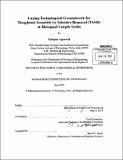Laying technological groundwork for Templated Assembly by Selective Removal (TASR) at biological length scales
Author(s)
Agarwal, Gunjan
DownloadFull printable version (19.14Mb)
Alternative title
Laying technological groundwork for TASR at biological length scales
Other Contributors
Massachusetts Institute of Technology. Dept. of Mechanical Engineering.
Advisor
Carol Livermore.
Terms of use
Metadata
Show full item recordAbstract
This work presents the size-selective sorting of biological cells using the assembly process known as Templated Assembly by Selective Removal (TASR). This research has demonstrated experimentally, for the first time, the selective self-assembly of mammalian as well as non-mammalian single cells into patterned hemispherical sites on rigid assembly templates using TASR. TASR-based size-selective assembly of biological systems represents a potentially valuable tool for biological applications from cell sorting and isolation of single cells to templating for artificial tissue generation. Not only is the assembly itself demonstrated to work effectively, but it is also demonstrated that this assembly technique can be made low cost and manufacturable by the use of polymer templates replicated from rigid master templates. Furthermore, the assembly process has been proven to be successful with both isotropic (spherical) and anisotropic (non-spherical) assembly components, which enables it to be applied to a wide range of biological specimens. Finally, an integrated theoretical model framework is also presented, which combines all of the key factors that play a role in determining assembly efficiency to produce guidelines for the design of the assembly system, so as to meet the constraints for successful assembly. In TASR, the system's free energy is minimized when components assemble in holes in the template surface that match the components' shapes and sizes. A combination of chemical and mechanical effects selectively removes all poorly matched components. Clonal isolate (SF9) cells derived from the Spodoptera frugiperda (Fall Armyworm) IPLB-SF21-AE cells (with a mean diameter of 15 microns) and mouse-derived non-small lung cancer cells (with a mean diameter of 20 microns) were successfully assembled using TASR onto patterned silicon templates in separate sets of experiments. The assembly sites comprised holes with hemispherical profiles etched in a silicon substrate using plasma etching to match the nearly spherical shapes of the cells used. A high assembly yield of a 100% and high cell density were observed for cell placement into sites with uniform diameters for both the cell lines. In addition, size selectivity was established for assembly into sets of heterogeneously patterned hemispherical sites with different diameters. High cell viability of nearly 99% was recorded using multiple testing procedures, confirming predictions from theory that the assembly environment is favorable for the growth and survival of both mammalian as well as non-mammalian cells. These results confirmed model predictions that assembly would be successful with the materials studied here under the experimentally-used assembly parameters. The full set of models and experiments addressed the effects of compliance of the assembly components and templates, components and assembly sites shapes, and the chemical and mechanical properties of the assembly environment. Together, the results of these experiments and models demonstrate that TASR is indeed a very versatile tool for structuring biological systems.
Description
Thesis (Ph. D.)--Massachusetts Institute of Technology, Dept. of Mechanical Engineering, 2012. Cataloged from PDF version of thesis. Includes bibliographical references (p. 191-196).
Date issued
2012Department
Massachusetts Institute of Technology. Department of Mechanical EngineeringPublisher
Massachusetts Institute of Technology
Keywords
Mechanical Engineering.